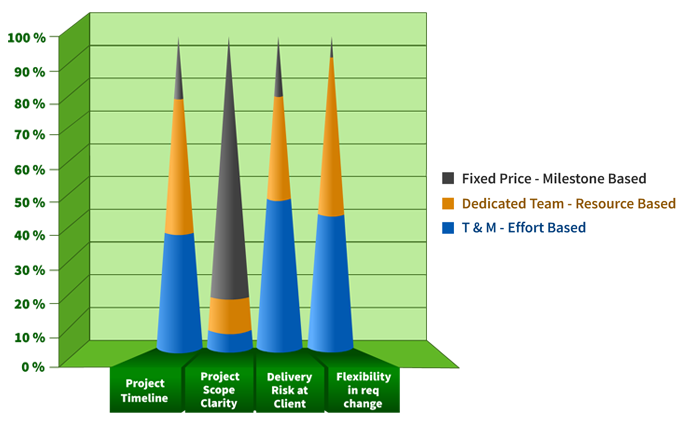Business Model
The information technology (IT) outsourcing has been inexorably growing, notching up needs for a vigorous pricing model to meet varying expectations.
Enterprises that have gone the outsourcing route now expect more value from their IT service providers and IT service vendors want potentially higher-margin work. Customers are looking for benefits afar cost savings and service improvements. They need new sources of value beyond cost savings, and we as service providers need new sources of competitive differentiation and margin levers.
The pricing models at Sveltoz have been evolving with time to best fit customer engagements, adapt client needs, and thus provide an opportunity to strike the right balance between the customer’s expectations of quality, timeliness and price, and our cost, operational efficiency and risk assessment.
Sveltoz pricing models could be broadly categorized into:
Time and Material (T&M) – Effort based.
This model is elected based on the below customer / project factors:
- Flexibility and agility in project execution.
- Frequently change in requirements and addition of new components.
- Considerable uncertainty in the scope and estimation of proposed assignment.
- Projects with ongoing long term milestones.
A team is assigned to the customer and the customer is billed for the actual time spent by the resources regardless of how long the project takes to completion – “Pay as u go” Model. With this model the work could be progressed even with the initial period of uncertainty.
Dedicated Team – Resource Based
This model is elected based on the below customer / project factors:
- First time engagement with the customer.
- Business has multiple projects to be outsourced and requires a dedicated team at their site to execute the projects.
- Projects with ongoing long term milestones.
- Frequently change in requirements and addition of new components.
- Tactful and competent business growth with no infrastructure investment.
- Considerable uncertainty in the scope and estimation of proposed assignment.
The dedicated team model works as a dedicated service provider for a period of time. This team acts as the virtual extension of the client’s in-house development team. The customer takes the onus of getting work done effectively from the team. Monthly bills are raised based on the number of resources dedicated every month.
Fixed Price – Milestone based
This model is elected based on the below customer / project factors:
- Clearly articulated scope with well defined requirements.
- Very less flexibility in requirement change and project execution.
- Customer’s IT processes are well understood.
- Estimable scope, timeline and cost, in the initial phases.
- Assignments with Quick turnaround including quality/functional testing.
- Scope changes result in additional charges / change in price.
- Project duration is fixed.
Entire risk of delivery, people and quality is owned by us. The invoices are raised at the end of agreed milestones. Customer doesn’t have any control to quantify resources and effort spent by the team.
Have questions in choosing a model?
With due diligence, we help our customers to chose the best fit pricing model by analyzing their requirements, budget, engagement modes along with risk assessment against each of the models.
